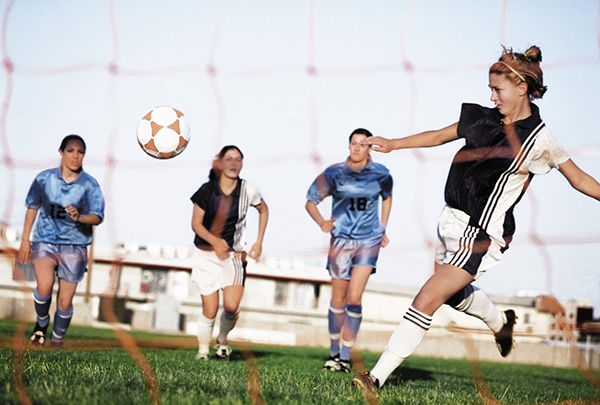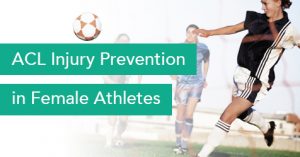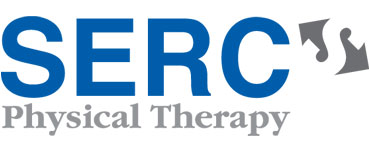By Shelby Troyer, PT, DPT, MS
Full-time PT and Sports Resident
If you have a teenage daughter, perhaps she or one of her peers has suffered a dreaded anterior cruciate ligament (ACL) tear.
It’s an injury that strikes many young female athletes, often taking them out of their beloved sports for 8 to 12 months at a time. The ACL, a ligament in the knee, is crucial for providing stability to the joint during movement, particularly in sports that require sudden changes in direction such as soccer and basketball.
ACL injuries can have long-term consequences if not rehabilitated properly. Treatment is costly and success — defined as returning to the same level of pre-injury competitiveness — is not guaranteed.
The good news is that addressing risk factors prior to injury can minimize the long-term consequences.
Relative to males, females are at increased risk for ACL tears because of intrinsic, non-modifiable factors, including hormonal differences, body mass index, previous knee or lower body injury, and differences in bone shape.
Obviously then, the focus of prevention is on extrinsic, modifiable factors.
MOVEMENT PATTERNS
Complicated biomechanics lab studies have shown that females tend to land from jumps and perform cutting and landing movements (planting and pivoting or side cut maneuvers, which typically occur in soccer and basketball) with incorrect movement mechanics, dramatically increase their ACL injury risk.
These mechanics include less bend at the hips and knees; increased inward collapse at the knee; increased inward rotation of the hip with outward rotation of the shin bone; and increased activation of the quadriceps muscle, which is on the front of the thigh.
These movement patterns increase strain on the ACL during strenuous activities.

HIP STRENGTH
The hips are an important stabilizer to the knee. Females tend to have weaker hip muscles than males, which predisposes them to knee injury because the hip muscles are not helping to stabilize the knee during explosive cutting and jumping movements.
CORE STRENGTH
Athletes with decreased core muscle strength who cannot adequately control movement of the body after a sudden disturbance of the body’s overall stability are at an increased risk of ACL injury.
Each of these extrinsic risk factors can be addressed through a proper strengthening and neuromuscular training program. They typically consist of balance exercises, knee joint stability exercises, plyometric (or jumping) exercises, agility drills, and sport-specific drills.
They are easy to incorporate into all training environments and settings and should be designed by a physical therapist or other professional knowledgeable in ACL injury prevention.
For more information on ACL injury prevention, please contact your nearest Drayer Physical Therapy Institute outpatient center.
Resources
Baldon, R.D., Serrao, F.V., Silva, R.S., & Piva, S.R. Effects of Functional Stabilization Training on Pain, Function, & Lower Extremity Biomechanics in Women with Patellofemoral Pain: A Randomized Clinical Trial. JOSPT. 2014 April; 44(4): 240-251.
Dufek, J.S. & Bates, B.T. Biomechanical Factors Associated with Injury During Landing in Jumping Sports. Sports Medicine. 1991 Dec; 326-337.
Houston, L.F., & Wojtys, E.M. Neuromuscular Performance Characteristics in Elite Female Athletes. Am J Sports Med. 1996; 12(5): 427-437.
Kokmyer, D., Wahoff, M., & Mymern, M. Suggestions from the Field for Returning to Sports Participation Following Anterior Cruciate Ligament Reconstruction: Alpine Skiing. JOSPT. 2012 April; 42(4): 313-325.
Leetun, D.T., et. al. Core Stability Measures as Risk Factors for Lower Extremity Injury in Athletes. Med Sci Sports Exerc. 2004; 36(6): 926-934.
Lephart, S.M., Abt, J.P., & Ferris, C.M. Neuromuscular Contributions to Anterior Cruciate Ligament Injuries in Females. Curr Opin Rheumatol. 2002; 14: 168- 173.
Plisky, P.J., Rauh, M.J., Kaminski, J., & Underwood, F.B. Star Excursion Balance Test as a Predictor of Lower Extremity Injury in High School Basketball Player. JOSPT. 2006; 36: 911-919.
Prapavessis, H. & McNair, P.J. Effects of Instruction in Jumping Technique and Experienced Jumping on Ground Reaction Forces. JOSPT. 1999; 29(6): 352- 356.
Prodromos, C.C., et. al. A meta-analysis of the incidence of anterior cruciate ligament tears as a function of gender, sport, and a knee injury-reduction regimen. Arthroscopy. 2007; 23: 1320-1325.
Smith, H.C., et. al. Risk Factors for Anterior Cruciate Ligament Injury: A Review of the Literature—Part 1: Neuromuscular and Anatomic Risk. Sports Health. 2012 Jan; 4(1): 69-78.
Smith, H.C., et. al. Risk Factors for Anterior Cruciate Ligament Injury: A Review of the Literature—Part 2: Hormonal, Genetic, Cognitive Function, Previous Injury, and Extrinsic Risk Factors. Sports Health. 2012 Mar; 4(2): 155-161.
Vaughan, L. Preseason Strength and Flexibility Imbalances Associated with Athletic Injuries in Female Collegiate Athletes. Am J Sports Med. 1991; 19: 76-81.
Verstegen, M., Falsone, S., Orr, R., & Smith, S. Suggestions from the Field for Returning to Sports Participation Following Anterior Cruciate Ligament Reconstruction: Football. 2012 April; 42(4): 337-344.
Webster, K.E., et. al. Effect of Fatigue on Landing Biomechanics After Anterior Cruciate Ligament Reconstruction Surgery. Medicine & Science in Sports & Exercise. 2012 May; 44(5): 910-916.

